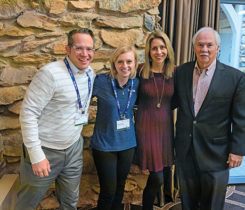World Golf Foundation’s Mona looks back, ahead
The hard numbers of golf’s overall 2017 performance will be out in the spring, but it was a good year from the standpoint of stability among those who participate in the game, World Golf Foundation CEO Steve Mona told Golfdom in an interview at the GIS.
“We needed to get to that point, and we’re there,” he emphasized. “The other thing that I was really pleased with is that we’re looking at how golf is consumed more broadly than we have in the past. Before, we looked at it strictly – it had to be on green grass golf courses, and that obviously is still the core of the game, but now we’re looking at it from the standpoint of other ways people engage with the game.”
Those “other ways” include driving ranges, he says, noting that “about 4 million people play only at a range,” or at “golfing as entertainment” facilities like Topgolf, which are introducing people to the game, as is simulator golf.
“Our definition is, if you have a regulation club in your hand, if you’re striking a regulation golf ball and getting some feedback on the shot, then that constitutes a golf experience.” This definition, he noted, was adopted in 2017 by the National Golf Foundation, and he is in agreement with it.
“If you and I went out at lunchtime,” he noted, “and we played a game of horse or one on one or knockout, and we came back to the office and people asked, ‘What’d you do at lunch?’ you’d say ‘Hey, we played basketball.’ But it wasn’t five on five in a gym with referees or a scoreboard, but yet in golf we seem to think golf’s only golf if it’s played in the traditional way – 18 holes, hole out every putt. We have to recognized that the way people are consuming the game has evolved.”
These experiences are exposing people to the game, he noted. “Now, obviously, we want to move them along and turn them into avid golfers,” but these introductory experiences, he said, are significant. “For 2017, that would be the big change I would point to.”
Looking ahead to the new year, Mona believes that three groups underrepresented in golf will be better serviced.
Those groups include women, who he noted are more than 50-plus percent of the overall population but only 24 percent of the golfing population. “We have a Women’s Task Force in place now that has a whole suite of programs and initiatives under way to bring women into the game, and we think we’re going to be successful. That’s going to be a gradual, long pull, he said, “but we think we’ll start to change the face of golf.”
The second group includes minorities, who are defined as African-Americans, Hispanics/Latinos and Asian-Americans, and who are 37 percent of the overall population but only 20 percent of the golfing population. He mentioned the work of golf’s Diversity Task Force, which is looking to expand minority involvement in the game through recreational play, competitive play, the number of minorities in golf’s national work force, and suppliers from which the game purchases goods and services.
The final group, is Millennials. It’s not so much a percentage issue with Millennials, Mona said, because the percentage of Millennials in the population is close to the percentage of them who play golf. “It’s more attitudinal.”
For them, he said, “Everything’s been delayed. They’ve gotten married later, they’re starting families later, buying homes later. But we can’t take the attitude that everything’s just being delayed, so everything’s going to be fine, and once Millennials get to a certain age everything is going to catch up.” That won’t work, he said, “because they just look at the game differently.” The Millennial Task Force, he said, is working on that, as well.
“Our ultimate goal,” Mona summed up, “is for golf to look like America looks.”










